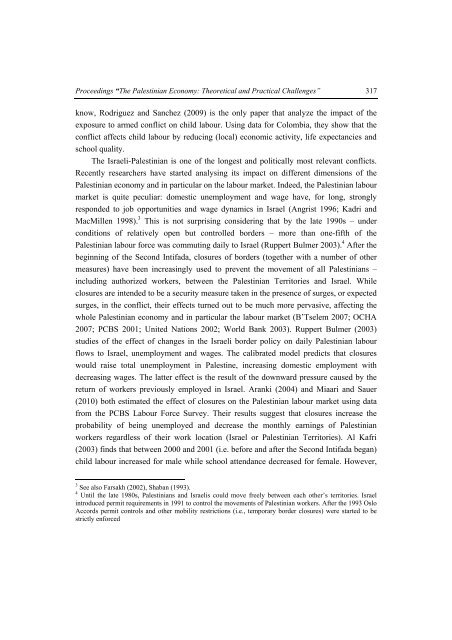The Palestinian Economy. Theoretical and Practical Challenges
The Palestinian Economy. Theoretical and Practical Challenges
The Palestinian Economy. Theoretical and Practical Challenges
Create successful ePaper yourself
Turn your PDF publications into a flip-book with our unique Google optimized e-Paper software.
Proceedings “<strong>The</strong> <strong>Palestinian</strong> <strong>Economy</strong>: <strong>The</strong>oretical <strong>and</strong> <strong>Practical</strong> <strong>Challenges</strong>” 317<br />
know, Rodriguez <strong>and</strong> Sanchez (2009) is the only paper that analyze the impact of the<br />
exposure to armed conflict on child labour. Using data for Colombia, they show that the<br />
conflict affects child labour by reducing (local) economic activity, life expectancies <strong>and</strong><br />
school quality.<br />
<strong>The</strong> Israeli-<strong>Palestinian</strong> is one of the longest <strong>and</strong> politically most relevant conflicts.<br />
Recently researchers have started analysing its impact on different dimensions of the<br />
<strong>Palestinian</strong> economy <strong>and</strong> in particular on the labour market. Indeed, the <strong>Palestinian</strong> labour<br />
market is quite peculiar: domestic unemployment <strong>and</strong> wage have, for long, strongly<br />
responded to job opportunities <strong>and</strong> wage dynamics in Israel (Angrist 1996; Kadri <strong>and</strong><br />
MacMillen 1998). 3 This is not surprising considering that by the late 1990s – under<br />
conditions of relatively open but controlled borders – more than one-fifth of the<br />
<strong>Palestinian</strong> labour force was commuting daily to Israel (Ruppert Bulmer 2003). 4 After the<br />
beginning of the Second Intifada, closures of borders (together with a number of other<br />
measures) have been increasingly used to prevent the movement of all <strong>Palestinian</strong>s –<br />
including authorized workers, between the <strong>Palestinian</strong> Territories <strong>and</strong> Israel. While<br />
closures are intended to be a security measure taken in the presence of surges, or expected<br />
surges, in the conflict, their effects turned out to be much more pervasive, affecting the<br />
whole <strong>Palestinian</strong> economy <strong>and</strong> in particular the labour market (B’Tselem 2007; OCHA<br />
2007; PCBS 2001; United Nations 2002; World Bank 2003). Ruppert Bulmer (2003)<br />
studies of the effect of changes in the Israeli border policy on daily <strong>Palestinian</strong> labour<br />
flows to Israel, unemployment <strong>and</strong> wages. <strong>The</strong> calibrated model predicts that closures<br />
would raise total unemployment in Palestine, increasing domestic employment with<br />
decreasing wages. <strong>The</strong> latter effect is the result of the downward pressure caused by the<br />
return of workers previously employed in Israel. Aranki (2004) <strong>and</strong> Miaari <strong>and</strong> Sauer<br />
(2010) both estimated the effect of closures on the <strong>Palestinian</strong> labour market using data<br />
from the PCBS Labour Force Survey. <strong>The</strong>ir results suggest that closures increase the<br />
probability of being unemployed <strong>and</strong> decrease the monthly earnings of <strong>Palestinian</strong><br />
workers regardless of their work location (Israel or <strong>Palestinian</strong> Territories). Al Kafri<br />
(2003) finds that between 2000 <strong>and</strong> 2001 (i.e. before <strong>and</strong> after the Second Intifada began)<br />
child labour increased for male while school attendance decreased for female. However,<br />
3 See also Farsakh (2002), Shaban (1993).<br />
4 Until the late 1980s, <strong>Palestinian</strong>s <strong>and</strong> Israelis could move freely between each other’s territories. Israel<br />
introduced permit requirements in 1991 to control the movements of <strong>Palestinian</strong> workers. After the 1993 Oslo<br />
Accords permit controls <strong>and</strong> other mobility restrictions (i.e., temporary border closures) were started to be<br />
strictly enforced
















